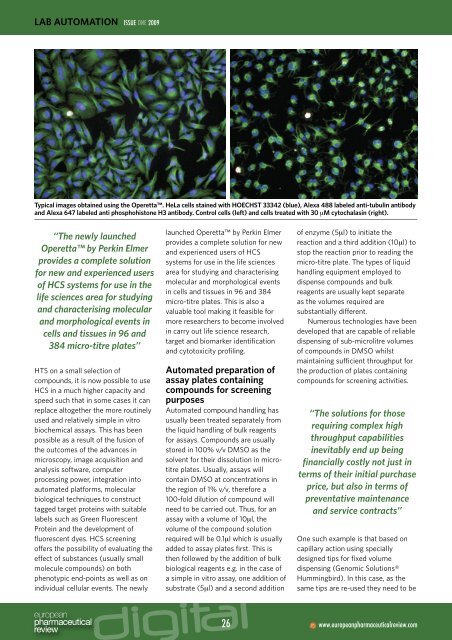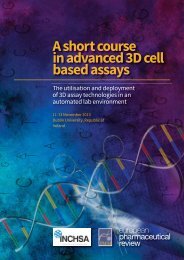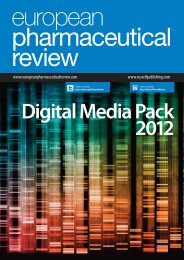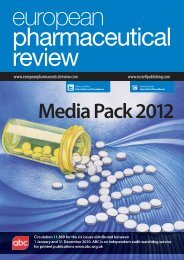Real time PCR - European Pharmaceutical Review
Real time PCR - European Pharmaceutical Review
Real time PCR - European Pharmaceutical Review
Create successful ePaper yourself
Turn your PDF publications into a flip-book with our unique Google optimized e-Paper software.
LAB AUTOMATION ISSUE 2009<br />
Typical images obtained using the Operetta. HeLa cells stained with HOECHST 33342 (blue), Alexa 488 labeled anti-tubulin antibody<br />
and Alexa 647 labeled anti phosphohistone H3 antibody. Control cells (left) and cells treated with 30 μM cytochalasin (right).<br />
‘‘The newly launched<br />
Operetta by Perkin Elmer<br />
provides a complete solution<br />
for new and experienced users<br />
of HCS systems for use in the<br />
life sciences area for studying<br />
and characterising molecular<br />
and morphological events in<br />
cells and tissues in 96 and<br />
384 micro-titre plates’’<br />
HTS on a small selection of<br />
compounds, it is now possible to use<br />
HCS in a much higher capacity and<br />
speed such that in some cases it can<br />
replace altogether the more routinely<br />
used and relatively simple in vitro<br />
biochemical assays. This has been<br />
possible as a result of the fusion of<br />
the outcomes of the advances in<br />
microscopy, image acquisition and<br />
analysis software, computer<br />
processing power, integration into<br />
automated platforms, molecular<br />
biological techniques to construct<br />
tagged target proteins with suitable<br />
labels such as Green Fluorescent<br />
Protein and the development of<br />
fluorescent dyes. HCS screening<br />
offers the possibility of evaluating the<br />
effect of substances (usually small<br />
molecule compounds) on both<br />
phenotypic end-points as well as on<br />
individual cellular events. The newly<br />
launched Operetta by Perkin Elmer<br />
provides a complete solution for new<br />
and experienced users of HCS<br />
systems for use in the life sciences<br />
area for studying and characterising<br />
molecular and morphological events<br />
in cells and tissues in 96 and 384<br />
micro-titre plates. This is also a<br />
valuable tool making it feasible for<br />
more researchers to become involved<br />
in carry out life science research,<br />
target and biomarker identification<br />
and cytotoxicity profiling.<br />
Automated preparation of<br />
assay plates containing<br />
compounds for screening<br />
purposes<br />
Automated compound handling has<br />
usually been treated separately from<br />
the liquid handling of bulk reagents<br />
for assays. Compounds are usually<br />
stored in 100% v/v DMSO as the<br />
solvent for their dissolution in microtitre<br />
plates. Usually, assays will<br />
contain DMSO at concentrations in<br />
the region of 1% v/v, therefore a<br />
100-fold dilution of compound will<br />
need to be carried out. Thus, for an<br />
assay with a volume of 10μl, the<br />
volume of the compound solution<br />
required will be 0.1μl which is usually<br />
added to assay plates first. This is<br />
then followed by the addition of bulk<br />
biological reagents e.g. in the case of<br />
a simple in vitro assay, one addition of<br />
substrate (5μl) and a second addition<br />
of enzyme (5μl) to initiate the<br />
reaction and a third addition (10μl) to<br />
stop the reaction prior to reading the<br />
micro-titre plate. The types of liquid<br />
handling equipment employed to<br />
dispense compounds and bulk<br />
reagents are usually kept separate<br />
as the volumes required are<br />
substantially different.<br />
Numerous technologies have been<br />
developed that are capable of reliable<br />
dispensing of sub-microlitre volumes<br />
of compounds in DMSO whilst<br />
maintaining sufficient throughput for<br />
the production of plates containing<br />
compounds for screening activities.<br />
‘‘The solutions for those<br />
requiring complex high<br />
throughput capabilities<br />
inevitably end up being<br />
financially costly not just in<br />
terms of their initial purchase<br />
price, but also in terms of<br />
preventative maintenance<br />
and service contracts’’<br />
One such example is that based on<br />
capillary action using specially<br />
designed tips for fixed volume<br />
dispensing (Genomic Solutions®<br />
Hummingbird). In this case, as the<br />
same tips are re-used they need to be<br />
26<br />
www.europeanpharmaceuticalreview.com






